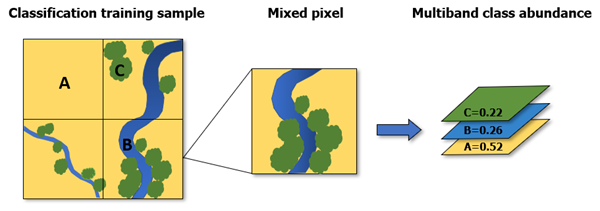Available with Image Analyst license.
Available with Spatial Analyst license.
Summary
Performs subpixel classification and calculates the fractional abundance of different land cover types for individual pixels.

Usage
This tool calculates the fractional cover for individual pixels that contain multiple land cover types. It generates a multiband raster in which each band corresponds to the fractional abundance of each land cover class. For example, you can use it to perform land cover classification on a multispectral image to identify photosynthetic vegetation, bare soil, and dead or nonphotosynthetic vegetation.
The order of the output multiband raster follows the order of the input spectral profile.
The number of classes cannot exceed the number of bands in the input raster. For example, you cannot extract information about more than 8 classes from an 8-band raster.
The following is an example of a spectral profile provided as a .json file:
{ "EsriEndmemberDefinitionFile" : 0, "FileVersion" : 1, "NumberEndmembers" : 3, "NumberBands" : 7, "Endmembers" : [ { "EndmemberID" : 1, "EndmemberName" : "urban", "SpectralProfile" : [ 88, 42, 48, 38, 86, 115, 59 ] }, { "EndmemberID" : 2, "EndmemberName" : "vegetation", "SpectralProfile" : [ 50, 21, 20, 35, 50, 110, 23 ] }, { "EndmemberID" : 3, "EndmemberName" : "water", "SpectralProfile" : [ 51, 20, 14, 9, 7, 116, 4 ] } ] }Classifier definition files (.ecd) generated from the Train Maximum Likelihood Classifier tool are the only classifier output currently supported.
Polygon features require the following field names:
- classname—A text field indicating the name of the class category
- classvalue—A long integer field containing the integer value for each class category
When calculating the fractional abundance of each land cover class, the solution can include negative coefficients or fractions. If this occurs, review the training samples in your input spectral profile to confirm that they accurately represent each class. If they appear correct, select Non-negative for Output Value Option.
Syntax
LinearSpectralUnmixing(in_raster, in_spectral_profile_file, {value_option})| Parameter | Explanation | Data Type |
in_raster | The input raster dataset. | Raster Dataset; Mosaic Dataset; Mosaic Layer; Raster Layer; File; Image Service |
in_spectral_profile_file | The spectral information for the different land cover classes. This can be provided as polygon features, a classifier definition file (.ecd) generated from the Train Maximum Likelihood Classifier tool, or a JSON file (.json) that contains the class spectral profiles. | File; Feature Layer; String |
value_option [value_option,...] (Optional) | Specifies how the output pixel values will be defined.
| String |
Return Value
| Name | Explanation | Data Type |
| out_raster | The output multiband raster dataset. | Raster |
Code sample
This example calculates the fractional abundance of classes from a classifier definition file (.ecd) and generates a multiband raster.
# Import system modules
import arcpy
from arcpy.sa import *
# Check out the ArcGIS Spatial Analyst extension license
arcpy.CheckOutExtension("SpatialAnalyst")
# Execute
unmixing_outputs = LinearSpectralUnmixing("C:/data/landsat7_image.crf",
"C:/data/train_maxi_likelihood_ecd_output.ecd", "SUM_TO_ONE;NON_NEGATIVE")
# Save output
unmixing_outputs.save("C:/data/unmixing_outputs.crf")This example calculates the fractional abundance of classes from a classifier definition file (.ecd) and generates a multiband raster.
# Import system modules
import arcpy
from arcpy.sa import *
# Check out the ArcGIS Spatial Analyst extension license
arcpy.CheckOutExtension("SpatialAnalyst")
# Define input parameters
inFile = "C:/data/landsat7_image.crf"
json_file = "C:/data/customized_endmembers.json"
options = "SUM_TO_ONE"
# Execute
unmixing_outputs = LinearSpectralUnmixing(inFile, json_file, options)
# Save output
unmixing_outputs.save("C:/data/unmixing_outputs_using_json.crf")This example calculates the fractional abundance of classes from a training sample feature class (.ecd) and generates a multiband raster.
# Import system modules
import arcpy
from arcpy.sa import *
# Check out the ArcGIS Spatial Analyst extension license
arcpy.CheckOutExtension("SpatialAnalyst")
# Define input parameters
inFile = "C:/data/landsat7_image.crf"
training_features = "C:/data/training_features.shp"
options = "SUM_TO_ONE;NON_NEGATIVE"
# Execute
unmixing_outputs = LinearSpectralUnmixing(inFile, training_features, options)
# Save output
unmixing_outputs.save("C:/data/unmixing_outputs_using_training_features.crf")Environments
Licensing information
- Basic: Requires Spatial Analyst or Image Analyst
- Standard: Requires Spatial Analyst or Image Analyst
- Advanced: Requires Spatial Analyst or Image Analyst